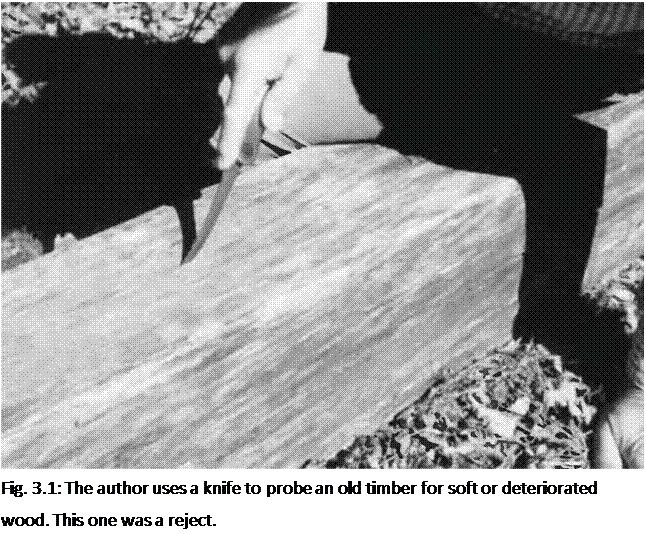Evaluating Recycled Timbers
Recycled timbers should be carefully evaluated before you buy them or agree to dismantle a building, so carry your wish list (more correctly called a timber schedule) with you to the procurement site. Firstly, timbers have to be of sufficient sectional size and length to do the job. Use actual usable length,
allowing for damaged ends or unusable ends due to mortise and tenon joints.
 Once you’ve established that you’ve got something potentially worthwhile, you need to look at each piece carefully for defects that might compromise their use on your project. With barn beams especially, all deterioration is not necessarily obvious: use a sharp knife to poke all four sides to check for soft wood. Reject any soft or “punky” pieces. Sometimes, you might get a good seven-foot post out of a twelve – foot beam, and that’s the best you can do. Catalog the piece as a good seven – footer. Do you need ten seven-foot posts? Well, here’s one of them.
Once you’ve established that you’ve got something potentially worthwhile, you need to look at each piece carefully for defects that might compromise their use on your project. With barn beams especially, all deterioration is not necessarily obvious: use a sharp knife to poke all four sides to check for soft wood. Reject any soft or “punky” pieces. Sometimes, you might get a good seven-foot post out of a twelve – foot beam, and that’s the best you can do. Catalog the piece as a good seven – footer. Do you need ten seven-foot posts? Well, here’s one of them.
Watch out for a mortise carved out of the middle of a timber that you want to use as a girder, as the void will greatly diminish bending strength. However, you might be able to use the piece as a post, or as a girt which will eventually be supported along its length by an intermediate post, or cordwood infilling.
Old timbers that have been under cover are likely to be in good condition, as are those fresh from a demolition site. However, timbers left out in the open for a year or two are almost certain to have begun a process of deterioration. It is so sad to see a beautiful old hand-hewn timber on the ground, and then to turn it over and find an inch of rotted wood on the underside. Even here, though, there is an exception. My friend Bob has some old virgin-growth heartwood timbers — twelve-by-twelves and the like — which have been lying on the ground for years and are still in excellent condition. I saw them myself, and was amazed. They just don’t make timbers like these anymore!
The use of recycled timbers may not be allowed in some code enforcement jurisdictions, because the timbers are not “graded” according to the building code — a subject already discussed in Chapter i. You need to know that you’ll be allowed to use the timbers before you spend a lot of time and money on them. As for stress load calculations, it may be hard to even judge the species of a ioo – year-old timber, never mind its grade. If we are planning to use the piece as an
important girder, it is best to use a conservatively low value as the unit stress rating for both shear and bending. If you see close-grained timbers with small knots or no knots, you know that these timbers are likely to be really strong. They’re likely to be really heavy, too.






Leave a reply